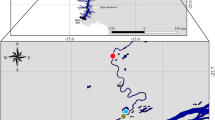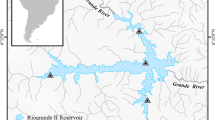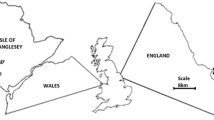Abstract
Niche partitioning occurs among coexisting populations to reduce the effects of competitive exclusion among species of similar niche. The aim of the present study is to verify the trophic niche partitioning and feeding behavior between two mustelids, the Giant otter and the Neotropical otter, through the dry and rainy season hydrologic of the Lower Xingu River. Our results suggest that the diets of both mustelids are composed primarily of fish of the family Anostomidae (Headstanders). Despite extensive niche overlap, our results indicate partitioning is facilitated by differences in niche breadth, with potential implications for conservation of both species in the case of declines in prey abundance and diversity. Both species inhabit an area recently impacted by completion of the Belo Monte Hydropower Plant, resulting in large changes to the hydrologic regime. Thus, our results provide important information for conservation efforts regarding the feeding behavior and co-occurrence of both species, as well as providing a baseline for monitoring future health of these mustelid populations. The present study is the first to test the hypothesis of niche partitioning between these two mustelids outside a protected area in the Amazon.





Similar content being viewed by others
Availability of data and material
We declare that all data in this scientific manuscript will be available upon request.
References
Alarcon, G. G. & P. C. Simões-Lopes, 2003. Preserved versus degraded coastal environments: a case study of the Neotropical otter in the Environmental Protection Area of Anhatomirim, Southern Brazil. Group Bull 20: 6–18.
Andrade, M. C., D. B. Fitzgerald, K. O. Winemiller, P. S. Barbosa & T. Giarrizzo, 2019. Trophic niche segregation among herbivorous serrasalmids from rapids of the lower Xingu River, Brazilian Amazon. Hydrobiologia 829: 265–280.
Araújo, M. S., D. I. Bolnick & C. A. Layman, 2011. The ecological causes of individual specialisation. Ecology Letters 14: 948–958.
Armbruster, J., P. van der Sleen & N. O. Lujan, 2018. Subfamily Hypostominae – Plecos and relatives. In van der Sleen, P. & J. S. Albert (eds), Field Guide to the Fishes of the Amazon, Orinoco, and Guianas. Princeton University Press, Princeton: 259–285.
Bonesi, L., P. Chanin & D. W. Macdonald, 2004. Competition between Eurasian otter Lutra lutra and American mink Mustela vison probed by niche shift. Oikos 106: 19–26.
Cabral, M. M., J. Zuanon, G. E. de Mattos & F. C. Rosas, 2010. Feeding habits of giant otters Pteronura brasiliensis (Carnivora: Mustelidae) in the Balbina hydroelectric reservoir, Central Brazilian Amazon. Zoologia 27: 47–53.
Camargo, M. & J. R. R. Ghilardi, 2009. Entre a Terra, as Águas e os Pescadores do Médio Rio Xingu - uma abordagem ecológica. 1st ed. Belém.
Carter, S. K. & F. C. Rosas, 1997. Biology and conservation of the giant otter Pteronura brasiliensis. Mammal Review 27: 1–26.
Charnov, E. L., 1976. Optimal foraging, the marginal value theorem. Theoretical Population Biology 9: 129–136.
Clarke, K. R. & R. N. Gorley, 2015. PRIMER v7: User Manual/Tutorial. Plymouth 296.
Clarke, K. R., J. R. Tweedley & F. J. Valesini, 2014. Simple shade plots aid better long-term choices of data pre-treatment in multivariate assemblage studies. Journal of the Marine Biological Association of the United Kingdom 94: 1–16.
da Silva, J. C., É. A. Gubiani, M. P. Neves & R. L. Delariva, 2017. Coexisting small fish species in lotic neotropical environments: evidence of trophic niche differentiation. Aquatic Ecology 51: 275–288.
Daura-Jorge, F. G., L. L. Wedekin, V. D. Q. Piacentini & P. C. Simões-Lopes, 2005. Seasonal and daily patterns of group size, cohesion and activity of the estuarine dolphin, Sotalia guianensis (PJ van Bénéden)(Cetacea, Delphinidae), in southern Brazil. Revista Brasileira de Zoologia 22: 1014–1021.
Dormann, C. F., B. Gruber & J. Fründ, 2008. Introducing the bipartite package: analysing ecological networks. R News 8: 8–11.
dos Reis, N. R., A. L. Peracchi, W. A. Pedro & I. P. de Lima, 2011. Mamíferos do Brasil, 2ª ed. Edur-UFRRJ, Rio de Janeiro.
Dunne, J. A., R. J. Williams & N. D. Martinez, 2002. Food-web structure and network theory: the role of connectance and size. Proceedings of the National Academy of Sciences 99: 12917–12922.
Duplaix, N., E. Evangelista & F. C. Rosas, 2015. Advances in the study of giant otter (Pteronura brasiliensis): ecology, behavior, and conservation: a review. Latin American Journal of Aquatic Mammals 10: 75–98.
Emlen, J. M., 1966. The role of time and energy in food preference. The American Naturalist 100: 611–617.
Fitzgerald, D. B., M. H. S. Perez, L. M. Sousa, A. P. Gonçalves, L. R. Py-Daniel, N. K. Lujan & J. G. Lundberg, 2018. Diversity and community structure of rapids-dwelling fishes of the Xingu River: implications for conservation amid large-scale hydroelectric development. Biological Conservation 222: 104–112.
Gallagher, A. J., D. S. Shiffman, E. E. Byrnes, C. M. Hammerschlag-Peyer & N. Hammerschlag, 2017. Patterns of resource use and isotopic niche overlap among three species of sharks occurring within a protected subtropical estuary. Aquatic Ecology 51: 435–448.
Garavello, J. C. & H. A. Britski, 2003. Family Anostomidae (Headstanders). In Reis, R. E., S. O. Kullander & C. J. Ferraris (eds), Check List of the Freshwater Fishes of South and Central America. Porto Alegre, Edipucrs: 71–84.
Gotelli, N. J. & A. M. Ellison, 2013. EcoSimR: null models for ecology, version 1.00.
Gotelli, N. J. & D. J. McCabe, 2002. Species co-occurrence: a meta-analysis of JM Diamond’s assembly rules model. Ecology 83: 2091–2096.
Groenendijk, J., F. Hajek, P. J. Johnson, D. W. Macdonald, J. Calvimontes, E. Staib & C. Schenck, 2014. Demography of the giant otter (Pteronura brasiliensis) in Manu National Park, south-eastern Peru: implications for conservation. PLoS ONE 9:
Groenendijk J, N. Duplaix, M. Marmontel, P. van Damme, C. Schenck, 2015. Pteronura brasiliensis. The IUCN Red List of Threatened Species 2015: e.T18711A21938411.
Hernández-Romero, P. C., C. Gutiérrez-Rodríguez, C. Valdespino & D. A. Prieto-Torres, 2018. The Role of Geographical and Ecological Factors on Population Divergence of the Neotropical otter Lontra longicaudis (Carnivora, Mustelidae). Evolutionary Biology 45: 37–55.
Instrução Normativa Interministerial 001. 3 janeiro de 2012. Diário Oficial da União.
Junk, W. J., M. T. F. Piedade, J. Schöngart, M. Cohn-Haft, J. M. Adeney & F. Wittmann, 2011. A classification of major naturally-occurring Amazonian lowland wetlands. Wetlands 31: 623–640.
Kasper, C. B., V. A. G. Bastazini, J. Salvi & H. C. Z. Grillo, 2008. Trophic ecology and the use of shelters and latrines by the Neotropical otter (Lontra longicaudis) in the Taquari Valley, Southern Brazil. Iheringia. Série Zoologia 98: 469–474.
Kawakami, E. & G. Vazzoler, 1980. Método gráfico e estimativa de índice alimentar aplicado no estudo de alimentação de peixes. Boletim do Instituto Oceanográfico: 205-207.
Krebs, C. J., 1999. Ecological Methodology. Benjamin Cummings, New York.
Krpo-Ćetković, J., S. Subotić, S. Skorić & D. Ćirović, 2019. Diet of the Eurasian otter (Lutra lutra) on the River Gradac, Serbia: predation in a brown trout-dominated stream. Aquatic Conservation: Marine and Freshwater Ecosystems 29: 282–291.
Leuchtenberger, C. & G. Mourão, 2009. Scent-marking of giant otter in the Southern Pantanal, Brazil. Ethology 115: 210–216.
Leuchtenberger, C., L. G. R. Oliveira-Santos, W. Magnusson & G. Mourão, 2013. Space use by giant otter groups in the Brazilian Pantanal. Journal of Mammalogy 94: 320–330.
Leuchtenberger, C., W. E. Magnusson & G. Mourão, 2015. Territoriality of giant otter groups in an area with seasonal flooding. PLoS ONE 10:
Leuchtenberger, C., M. L. Rheingantz, C. A. Zucco, A. C. Catella, W. E. Magnusson & G. Mourão, 2020. Giant otter diet differs between habitats and from fisheries offtake in a large Neotropical floodplain. Journal of Mammalogy 101: 1650–1659.
MacArthur, R. H. & E. R. Pianka, 1966. On optimal use of a patchy environment. The American Naturalist 100: 603–609.
May, R. M., 1974. On the theory of niche overlap. Theoretical Population Biology 5: 297–332.
Menezes, N. A., 2003. Family Acestrorhynchidae (Acestrorhynchids). In Reis, R. E., S. O. Kullander & C. J. Ferraris (eds), Check List of the Freshwater Fishes of South and Central America. Porto Alegre, Edipucrs: 231–233.
Mesquita, E. M. C., R. E. A. Cruz, G. Hallwass & V. J. Isaac, 2019. Fishery parameters and population dynamics of silver croaker on the Xingu river, Brazilian Amazon. Boletim do Instituto de Pesca 45: 1–11.
Muanis, M.C. & L. F. B. Oliveira, 2011. Habitat Use and Food Niche Overlap by Neotropical otter, Lontra longicaudis, and Giant otter, Pteronura brasiliensis, in the Pantanal Wetland, Brazil. Proceedings of Xth International Otter Colloquium, IUCN Otter Spec. Group Bull 28A: 76–85.
Oyakawa, O. T. & G. M. T. Mattox, 2018. Family Erythrinidae – Wolf-fishes and yarrows. In van der Sleen, P. & J. S. Albert (eds), Field Guide to the Fishes of the Amazon, Orinoco, and Guianas. Princeton University Press, Princeton: 156–158.
Papastamatiou, Y. P., B. M. Wetherbee, C. G. Lowe & G. L. Crow, 2006. Distribution and diet of four species of carcharhinid shark in the Hawaiian Islands: evidence for resource partitioning and competitive exclusion. Marine Ecology Progress Series 320: 239–251.
Pardini, R., 1998. Feeding ecology of the neotropical river otter Lontra longicaudis in an Atlantic Forest stream, south-eastern Brazil. Journal of Zoology 245: 385–391.
Pianka, E. R., 1974. Niche overlap and diffuse competition. Proceedings of the National Academy of Sciences 71: 2141–2145.
Quintela, F. M., L. G. S. Artioli & R. A. Porciuncula, 2012. Diet of Lontra longicaudis (Olfers, 1818) (Carnivora: Mustelidae) in three limnic systems in southern Rio Grande do Sul state, Brazil. Brazilian Archives of Biology and Technology 55: 877–886.
R Development Core Team, 2019. R: A Language and Environment for Statistical Computing.
Rheingantz, M. L. & C. S. Trinca, 2015. Lontra longicaudis. The IUCN Red List of Threatened Species 2015: e.T12304A21937379.
Rheingantz, M. L., H. F. Waldemarin, L. Rodrigues & T. P. Moulton, 2011. Seasonal and spatial differences in feeding habits of the Neotropical otter Lontra longicaudis (Carnivora: Mustelidae) in a coastal catchment of southeastern Brazil. Zoologia. Curitiba 28: 37–44.
Rheingantz, M. L., J. F. S. de Menezes & B. de Thoisy, 2014. Defining Neotropical otter Lontra longicaudis distribution, conservation priorities and ecological frontiers. Tropical Conservation Science 7: 214–229.
Rheingantz, M. L., V. M. Santiago-Plata & C. S. Trinca, 2017. The Neotropical otter Lontra longicaudis: a comprehensive update on the current knowledge and conservation status of this semiaquatic carnivore. Mammal Review 47: 291–305.
Sabaj Pérez, M. H., 2015. Where the Xingu bends and will soon break. American Scientist 103: 395–397.
Schirmer, A., J. Hoffmann, J. A. Eccard & M. Dammhahn, 2020. My niche: individual spatial niche specialization affects within-and between-species interactions. Proceedings of the Royal Society B 287: 20192211.
Schofield, K. A., L. C. Alexander, C. E. Ridley, M. K. Vanderhoof, K. M. Fritz, B. C. Autrey, J. E. DeMeester, W. G. Kepner, C. R. Lane, S. G. Leibowitz & A. I. Pollard, 2018. Biota connect aquatic habitats throughout freshwater ecosystem mosaics. JAWRA Journal of the American Water Resources Association 54: 372–399.
Sidlauskas, B. & J. L. O. Birindelli, 2018. Family Anostomidae – Toothed Headstanders. In van der Sleen, P. & J. S. Albert (eds), Field Guide to the Fishes of the Amazon, Orinoco, and Guianas. Princeton University Press, Princeton: 82–89.
Sih, A. & B. Christensen, 2001. Optimal diet theory: when does it work, and when and why does it fail? Animal Behaviour 61: 379–390.
Silva, R. E., F. C. W. Rosas & J. Zuanon, 2013. Feeding ecology of the giant otter (Pteronura brasiliensis) and the Neotropical otter (Lontra longicaudis) in Jaú National Park, Amazon, Brazil. Journal of Natural History 48: 465–479.
Souza, K. S., V. A. Bastazini & E. P. Colares, 2013. Feeding ecology of the Neotropical otter Lontra longicaudis in the Lower Arroio Grande River, southern Brazil. Anais da Academia Brasileira de Ciências 85: 285–294.
Strauss, R. E., 1979. Reliability Estimates for Ivlevˈs Electivity Index, the Forage Ratio, and a Proposed Linear Index of Food Selection. Transactions of the American Fisheries Society 108: 344–352.
Thompson, R. M., U. Brose, J. A. Dunne, R. O. Hall Jr., S. Hladyz, R. L. Kitching, N. D. Martinez, H. Rantala, T. N. Romanuk, D. B. Stouffer & J. M. Tylianakis, 2012. Food webs: reconciling the structure and function of biodiversity. Trends in Ecology & Evolution 27: 689–697.
Trigila, A. P., J. J. Gómez, M. H. Cassini & J. I. Túnez, 2015. Genetic diversity in the Neotropical river otter, Lontra longicaudis (Mammalia, Mustelidae), in the Lower Delta of Paraná River, Argentina and its relation with habitat suitability. Hydrobiologia 768: 287–298.
Vermaat, J. E., J. A. Dunne & A. J. Gilbert, 2009. Major dimensions in food-web structure properties. Ecology 90: 278–282.
Wiens, J. J., D. D. Ackerly, A. P. Allen, B. L. Anacker, L. B. Buckley, H. V. Cornell, et al., 2010. Niche conservatism as an emerging principle in ecology and conservation biology. Ecology Letters 13: 1310–1324.
Acknowledgements
CGM was funded by Coordination for the Improvement of Higher Education Personnel (CAPES); JH was funded by a Fulbright Post-Doctoral grant, Fulbright Commission Brazil; TG receives productivity grant from the National Council for Scientific and Technological Development (CNPq # 311078/2019-2), and MCA is funded by National Program for Post-Doctoral (PNPD/CAPES # 2017-6; financial code 001). This article was developed at the Aquatic Ecology and Fisheries Post-Graduate Program of the Federal University of Pará (PPGEAP/UFPA) as the Master Dissertation of the first author. This study was funded by Norte Energia S.A. and Fundação de Amparo e Desenvolvimento da Pesquisa (FADESP).
Funding
Coordenação de Aperfeiçoamento de Pessoal de Nível Superior Finance Code 001, and by PROPESP/UFPA; Fulbright Commission Brazil; Conselho Nacional de Desenvolvimento Científico e Tecnológico.
Author information
Authors and Affiliations
Contributions
Carine G. Moraes, Tommaso Giarrizzo and Marcelo C. Andrade contributed to the study conception and design. Material preparation, data collection and analysis were performed by Carine G. Moraes, Tommaso Giarrizzo, and Marcelo C. Andrade. The first draft of the manuscript was written by Carine G. Moraes and all authors commented on previous versions of the manuscript. All authors read and approved the final manuscript.
Corresponding author
Ethics declarations
Conflict of interest
There is no conflict of interest to declare.
Ethical approval
Not applicable, all data including animal subjects were conceded by Norte Energia S.A., the company authorized by the Instituto Brasileiro do Meio Ambiente e dos Recursos Naturais Renováveis (IBAMA) to collect at the Xingu River in the area of influence of the Belo Monte Hydropower Plant.
Additional information
Handling editor: Stuart Halse
Publisher's Note
Springer Nature remains neutral with regard to jurisdictional claims in published maps and institutional affiliations.
Supplementary Information
Below is the link to the electronic supplementary material.
10750_2021_4614_MOESM1_ESM.docx
Electronic supplementary material 1 (DOCX 95 kb) Online Resource Prey items’ indices (Online Resource 1), prey items’ significance (Online Resource 2), Relative abundance of fish collected using gillnets (Online Resource 3), Relative abundance of the eight fish families (Online Resource 4), Ivlev’s index of electivity (Online Resource 5).
Rights and permissions
About this article
Cite this article
Moraes, C.G., Hegg, J., Giarrizzo, T. et al. Feeding behavior and trophic niche partitioning between co-existing river otter species. Hydrobiologia 848, 4167–4177 (2021). https://doi.org/10.1007/s10750-021-04614-w
Received:
Revised:
Accepted:
Published:
Issue Date:
DOI: https://doi.org/10.1007/s10750-021-04614-w




